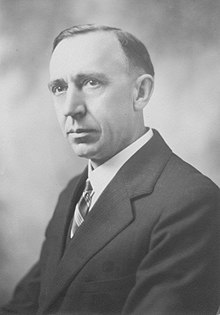Edward Monroe Freeman
Edward Monroe Freeman | |
|---|---|
 | |
| Born | February 12, 1875 |
| Died | February 5, 1954 (aged 78)[1] |
| Nationality | American |
| Scientific career | |
| Fields | Phytopathology |
| Academic advisors | Conway MacMillan, Harry Marshall Ward |
| Notable students | Elvin C. Stakman[1] |
Edward Monroe Freeman (February 12, 1875 – February 5, 1954)[2] was an American botanist.
Early life[edit]
Born at St. Paul to Swiss parents, Freeman went to public schools and graduated from Central High School 1892. Next, Freeman did not initially go to college for agriculture. He instead enrolled at the University of Minnesota's College of Science, Literature, and the Arts rather than their University Farm.[1]
Botanist[edit]
Freeman was persuaded by professor of botany Conway MacMillan to become a botanist. He graduated with a B.Sc. in 1898, and became a lecturer and did graduate work there, obtaining his M.Sc. in 1899.[1]
Direction decided[edit]
The next year Freeman suddenly struck upon the decision to become a plant pathologist while he was at Wood's Hole in Massachusetts for the summer.[1]
Pathologist[edit]
He arranged to go the next year to study at Cambridge University under Harry Marshall Ward, and thus began one of Freeman's most notable accomplishments: Introducing a great deal of European knowledge of plant pathology and methods to American education and practice. Ward and Freeman would work together for only the next year; they entered controversies and resolved them with relative ease, and by the end of the year had settled several famous questions of seed pathology and rust taxonomy. It was one of these - details of seeds residency in a Lolium temulentum-Puccinia rust pathosystem - that also became Freeman's PhD in a few years.[1]
In 1902 he returned to U Minn as a lecturer, and then assistant professor of botany and plant pathology[1] in 1908[citation needed]. Although in the future universities would embrace applied disciplines, erect new departments for them, and teach courses specifically about them, at the time classical education was the goal. Freeman proposed these changes as early as his return in 1902 but his mentor MacMillan was his greatest opposition. Eventually he would relent, however, and botany moved beyond pure theory for the first time at the College. Then, in 1907, the University wired him, asking him to found an entirely new department. He agreed, and before he could even return the University created it as the Division of Plant Pathology and Botany in the Agriculture Department and Freeman was given charge of it upon his return. In 1909, a local high school teacher named Stakman became only the third lecturer in the Division, and its first grad student.[1]
Eventually, Freeman became dean of the College[3] in 1917. One of his best known works of this time is Minnesota Plant Diseases. He retired in 1943, and died at his home nearby 11 years later on February 5, 1954.[1]
References[edit]
- ^ a b c d e f g h i Peterson, Paul D. (2001). "E.M. Freeman: Early Research on Cereal Diseases and the Rise of Plant Pathology at the University of Minnesota". Annual Review of Phytopathology. 39 (1). Annual Reviews: 13–26. doi:10.1146/annurev.phyto.39.1.13. ISSN 0066-4286. PMID 11701857.
- ^ Stakman, E. C.; Christensen, J. J. (20 August 1954). "Edward Monroe Freeman, Pioneer Plant Pathologist". Science. 120 (3112): 285–286. Bibcode:1954Sci...120..285S. doi:10.1126/science.120.3112.285. JSTOR 1682495. PMID 17799753.
- ^ "Dean E. M. Freeman". Digital Public Library of America. 2021-06-02. Retrieved 2021-06-02.
- This article incorporates text from a publication now in the public domain: Gilman, D. C.; Peck, H. T.; Colby, F. M., eds. (1905). New International Encyclopedia (1st ed.). New York: Dodd, Mead.
{{cite encyclopedia}}: Missing or empty|title=(help)
Authored bibliography[edit]
- Freeman, E. M. (1902). "Experiments on the Brown Rust of Bromes (Puccinia dispersa)". Annals of Botany. 16 (63). Oxford University Press: 487–494. doi:10.1093/oxfordjournals.aob.a088885. eISSN 1095-8290. ISSN 0305-7364. JSTOR 43235186. OCLC 1167493298.
- Freeman, Edward Monroe (1904). "I.—The seed-fungus of Lolium temulentum, L., the darnel". Philosophical Transactions of the Royal Society of London. Series B, Containing Papers of a Biological Character. 196 (214–224). The Royal Society: 1–27. doi:10.1098/rstb.1904.0001. ISSN 0264-3960.
- Freeman, Edward Monroe (1905). Minnesota Plant Diseases. Botanical Series V. Saint Paul, Minnesota. pp. xxiii+432. ISBN 978-1376700329.
{{cite book}}: CS1 maint: location missing publisher (link) 8 volumes. 211 figures.
- "Freeman's Minnesota Plant Diseases.-Report of the Survey, Botanical Series. E. M. Freeman". The American Naturalist. 40 (474). University of Chicago Press: 463. 1906. doi:10.1086/278639. ISSN 0003-0147.
- Hasselbring, H. (1906). "Minnesota Plant Diseases. E. M. Freeman". Botanical Gazette. 41 (1). University of Chicago Press: 72–73. doi:10.1086/328712. ISSN 0006-8071.
- Edward Monroe Freeman; Johnson, E. C. "The rusts of grain in the United States". United States Department of Agriculture Bulletin 1911 No.216. CABD 20057001278[permanent dead link].
